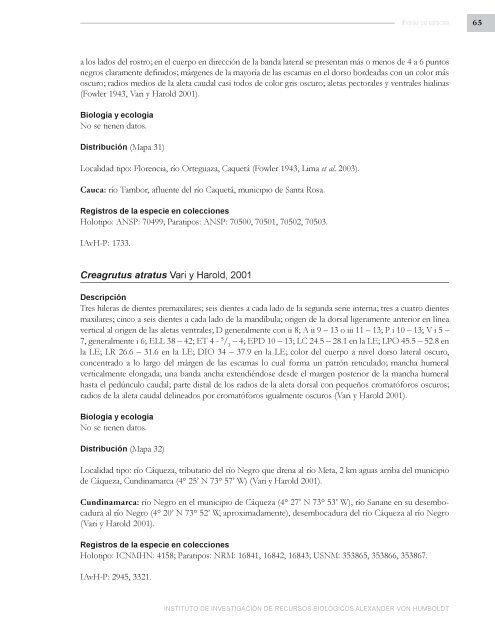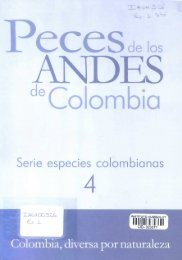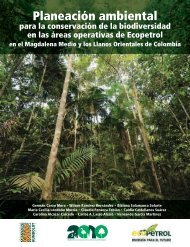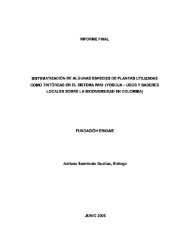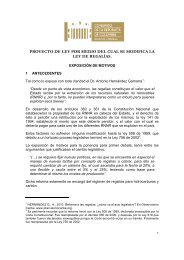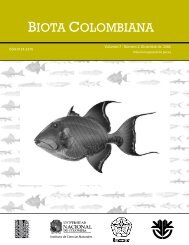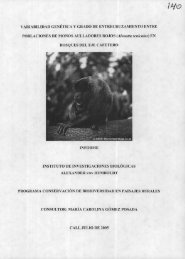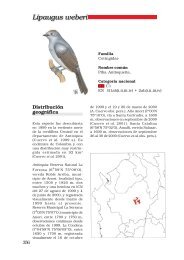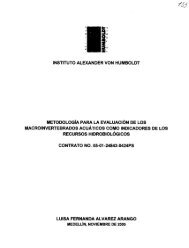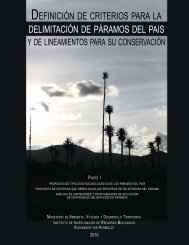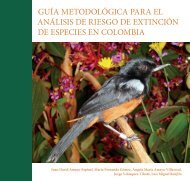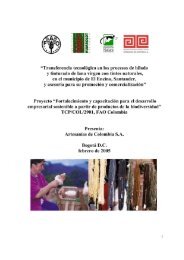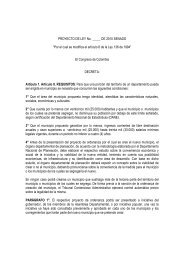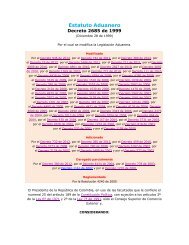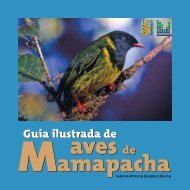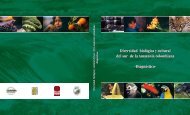- Page 1 and 2:
PECES DE LOS ANDES DE COLOMBIA Guí
- Page 3 and 4:
Potamotrygon magdalenae FERNANDO GA
- Page 5:
A Plutarco Cala Cala, por sus valio
- Page 9:
Presentación Desde la creación de
- Page 13: Agradecimientos Los autores agradec
- Page 17 and 18: C INTRODUCCIÓN olombia cuenta con
- Page 19 and 20: • LR - Longitud del rostro • LP
- Page 21 and 22: INTRODUCCIÓN distribución de espe
- Page 23: INTRODUCCIÓN ¿Porqué se encuentr
- Page 27 and 28: Clave de órdenes de peces presente
- Page 29 and 30: CLAVES TAXONÓMICAS 5 Rostro grueso
- Page 31 and 32: CLAVES TAXONÓMICAS 2 Lóbulo en el
- Page 33: CLAVES TAXONÓMICAS 5 Aleta anal co
- Page 37 and 38: MYLIOBATIFORMES Familia Potamotrygo
- Page 39 and 40: Registros de la especie en coleccio
- Page 41 and 42: Familia Curimatidae Cyphocharax mag
- Page 43 and 44: FICHAS DE ESPECIES Descripción (Fi
- Page 45 and 46: Leporinus striatus Kner, 1858 Sinon
- Page 47 and 48: Distribución (Mapa 11) Localidad t
- Page 49 and 50: Registros de la especie en coleccio
- Page 51 and 52: FICHAS DE ESPECIES Biología y ecol
- Page 53 and 54: FICHAS DE ESPECIES Usocoello, 50 m
- Page 55 and 56: Registros de la especie en coleccio
- Page 57 and 58: FICHAS DE ESPECIES IMCN: 91, 114, 2
- Page 59 and 60: Bryconamericus guizae Román-Valenc
- Page 61 and 62: FICHAS DE ESPECIES elongada; con un
- Page 63: Distribución (Mapa 29) FICHAS DE E
- Page 67 and 68: Creagrutus caucanus Eigenmann, 1913
- Page 69 and 70: Genycharax tarpon Eigenmann, 1912 N
- Page 71 and 72: Distribución (Mapa 39) FICHAS DE E
- Page 73 and 74: Hemibrycon colombianus Eigenmann, 1
- Page 75 and 76: FICHAS DE ESPECIES Biología y ecol
- Page 77 and 78: Microgenys minuta Eigenmann, 1913 S
- Page 79 and 80: Triportheus magdalenae (Steindachne
- Page 81 and 82: FICHAS DE ESPECIES Cauca: ríos Hon
- Page 83 and 84: Brycon oligolepis Regan, 1913 Nombr
- Page 85 and 86: Roeboides dayi (Steindachner, 1878)
- Page 87 and 88: Subfamilia Cheirodontinae Saccoderm
- Page 89 and 90: Gephyrocharax caucanus Eigenmann, 1
- Page 91 and 92: Macrodon ferox Gill, 1858 : 411. Ma
- Page 93 and 94: Distribución (Mapa 65) Caquetá: q
- Page 95 and 96: Lebiasina narinensis Ardila Rodríg
- Page 97 and 98: SILURIFORMES Familia Cetopsidae Pse
- Page 99 and 100: Registros de la especie en coleccio
- Page 101 and 102: Registros de la especie en coleccio
- Page 103 and 104: FICHAS DE ESPECIES manchas oscuras,
- Page 105 and 106: FICHAS DE ESPECIES 2002); presenta
- Page 107 and 108: FICHAS DE ESPECIES Pesca (4° 30’
- Page 109 and 110: Distribución (Mapa 83) FICHAS DE E
- Page 111 and 112: FICHAS DE ESPECIES Quebrada Guamal;
- Page 113 and 114: FICHAS DE ESPECIES río Peralonso;
- Page 115 and 116:
FICHAS DE ESPECIES barbillones cort
- Page 117 and 118:
FICHAS DE ESPECIES Descripción (Fi
- Page 119 and 120:
FICHAS DE ESPECIES IAvH-P: 526, 166
- Page 121 and 122:
Distribución (Mapa 98) Localidad t
- Page 123 and 124:
Registros de la especie en coleccio
- Page 125 and 126:
FICHAS DE ESPECIES Biología y ecol
- Page 127 and 128:
FICHAS DE ESPECIES Boyacá: quebrad
- Page 129 and 130:
Distribución (Mapa 109) Localidad
- Page 131 and 132:
FICHAS DE ESPECIES el río Bermell
- Page 133 and 134:
Familia Loricariidae Subfamilia Lor
- Page 135 and 136:
Dasyloricaria seminuda (Eigenmann y
- Page 137 and 138:
FICHAS DE ESPECIES oscuras transver
- Page 139 and 140:
FICHAS DE ESPECIES escudos laterale
- Page 141 and 142:
Pterygoplichthys undecimalis (Stein
- Page 143 and 144:
Ancistrus triradiatus Eigenmann, 19
- Page 145 and 146:
Chaetostoma fischeri Steindachner,
- Page 147 and 148:
Chaetostoma marginatum Regan, 1904
- Page 149 and 150:
Chaetostoma sovichthys Schultz, 194
- Page 151 and 152:
Chaetostoma vagum Fowler, 1943 Sino
- Page 153 and 154:
Dolichancistrus atratoensis (Dahl,
- Page 155 and 156:
FICHAS DE ESPECIES largo seis en la
- Page 157 and 158:
FICHAS DE ESPECIES Cali y Buga; rí
- Page 159 and 160:
Distribución (Mapa 151) Localidad
- Page 161 and 162:
FICHAS DE ESPECIES Cauca: río Ovej
- Page 163 and 164:
Registros de la especie en coleccio
- Page 165 and 166:
FICHAS DE ESPECIES 17.5’’N 75º
- Page 167 and 168:
Pimelodella modestus (Günther, 186
- Page 169 and 170:
Rhamdia duquei Eigenmann y Pearson,
- Page 171 and 172:
Pimelodus blochii Valenciennes, 184
- Page 173 and 174:
Pseudoplatystoma fasciatum (Linneau
- Page 175 and 176:
Nombres comunes Doncella, niña, se
- Page 177 and 178:
Distribución (Mapa 169) Localidad
- Page 179 and 180:
Familia Apteronotidae FICHAS DE ESP
- Page 181 and 182:
Apteronotus mariae (Eigenmann y Fis
- Page 183 and 184:
Poecilia caucana (Steindachner, 188
- Page 185 and 186:
Synbranchus marmoratus Bloch, 1795
- Page 187 and 188:
Caquetaia kraussii (Steindachner, 1
- Page 189:
Distribución (Mapa 182) Localidad
- Page 193 and 194:
L METODOLOGÍA PARA COLECTA Y ESTUD
- Page 195 and 196:
METODOLOGÍA PARA COLECTA Y ESTUDIO
- Page 197 and 198:
METODOLOGÍA PARA COLECTA Y ESTUDIO
- Page 199 and 200:
METODOLOGÍA PARA COLECTA Y ESTUDIO
- Page 201 and 202:
1. 2. 3. 4. 5. 6. Figura 182 - Proc
- Page 203:
5 REFERENCIAS BIBLIOGRÁFICAS
- Page 206 and 207:
206 PECES DE LOS ANDES DE COLOMBIA
- Page 208 and 209:
208 PECES DE LOS ANDES DE COLOMBIA
- Page 210 and 211:
210 PECES DE LOS ANDES DE COLOMBIA
- Page 212 and 213:
212 PECES DE LOS ANDES DE COLOMBIA
- Page 214 and 215:
214 PECES DE LOS ANDES DE COLOMBIA
- Page 216 and 217:
216 PECES DE LOS ANDES DE COLOMBIA
- Page 218 and 219:
218 PECES DE LOS ANDES DE COLOMBIA
- Page 221 and 222:
A: abreviación para la aleta anal.
- Page 223 and 224:
DENTICIÓN: patrón de dientes, inc
- Page 225 and 226:
GLOSARIO INTRODUCIDA: cualquier esp
- Page 227:
7 ANEXOS
- Page 231 and 232:
Anexo II Lista de peces de los Ande
- Page 233 and 234:
ANEXO 2 Dupouyichthys sapito Scultz
- Page 235:
ANEXO 2 Pimelodella modestus (Günt
- Page 239 and 240:
Figura 1 - Medidas peces Figura 2 -
- Page 241 and 242:
Figura 5a - Aleta dorsal ausente Fi
- Page 243 and 244:
Figura 10a - Línea lateral interru
- Page 245 and 246:
Figura 18a - Placas en más de dos
- Page 247 and 248:
Figura 26a - Pedúnculo caudal depr
- Page 249 and 250:
Figura 33a - Caudal con banda longi
- Page 251:
Figura 40a - Dientes en linea recta
- Page 255 and 256:
Figura - 47 Figura - 48 Figura - 49
- Page 257 and 258:
Figura - 53 Figura - 54 Figura - 55
- Page 259 and 260:
Figura - 59 Figura - 60 Figura - 61
- Page 261 and 262:
Figura - 65 Figura - 66 Figura - 67
- Page 263 and 264:
Figura - 71 Figura - 72 Figura - 73
- Page 265 and 266:
Figura - 77 Figura - 78 Figura - 79
- Page 267 and 268:
Figura - 83 Figura - 84 Figura - 85
- Page 269 and 270:
Figura - 89 Figura - 90 Figura - 91
- Page 271 and 272:
Figura - 95 Figura - 96 Figura - 97
- Page 273 and 274:
Figura - 101 Figura - 102 LÁMINAS
- Page 275 and 276:
Figura - 107 Figura - 108 Figura -
- Page 277 and 278:
Figura - 115 Figura - 116 Figura -
- Page 279 and 280:
Figura - 121 Figura - 122 Figura -
- Page 281 and 282:
Figura - 127 Figura - 128 Figura -
- Page 283 and 284:
Figura - 134 Figura - 135 Figura -
- Page 285 and 286:
Figura - 140 Figura - 141 Figura -
- Page 287 and 288:
Figura - 146 Figura - 147 Figura -
- Page 289 and 290:
Figura - 152 Figura - 153 Figura -
- Page 291 and 292:
Figura - 158 Figura - 159 Figura -
- Page 293 and 294:
Figura - 165 Figura - 166 LÁMINAS
- Page 295 and 296:
Figura - 171 Figura - 172 Figura -
- Page 297:
Figura - 176 Figura - 177 Figura -
- Page 301 and 302:
Mapa 1 - Potamotrygon magdalenae Ma
- Page 303 and 304:
Mapa 9 - Leporinus striatus Mapa 10
- Page 305 and 306:
Mapa 17 - Astyanax magdalenae Mapa
- Page 307 and 308:
Mapa 25 - Bryconamericus huilae Map
- Page 309 and 310:
Mapa 33 - Creagrutus brevipinnis Ma
- Page 311 and 312:
Mapa 41 - Hemibrycon carrilloi Mapa
- Page 313 and 314:
Mapa 49 - Triportheus magdalenae Ma
- Page 315 and 316:
Mapa 57 - Roeboides dayi Mapa 58 -
- Page 317 and 318:
Mapa 65 - Lebiasina elongata Mapa 6
- Page 319 and 320:
Mapa 73 - Xyliphius magdalenae Mapa
- Page 321 and 322:
Mapa 81 - Trichomycterus nigromacul
- Page 323 and 324:
Mapa 89 - Trichomycterus transandia
- Page 325 and 326:
Mapa 97 - Astroblepus cyclopus Mapa
- Page 327 and 328:
Mapa 105 - Astroblepus marmoratus M
- Page 329 and 330:
Mapa 113 - Astroblepus unifasciatus
- Page 331 and 332:
Mapa 121 - Spatuloricaria caquetae
- Page 333 and 334:
Mapa 129 - Ancistrus triradiatus Ma
- Page 335 and 336:
Mapa 137 - Chaetostoma sovichthys M
- Page 337 and 338:
Mapa 145 - Dolichancistrus fuesslii
- Page 339 and 340:
Mapa 153 - Cetopsorhamdia boquillae
- Page 341 and 342:
Mapa 161 - Rhamdia quelen Mapa 162
- Page 343 and 344:
Mapa 169 - Gymnotus ardilai Mapa 17
- Page 345 and 346:
Mapa 177 - Priapichthys caliensis M


